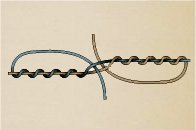HUNTING NEWS CATEGORIES
© 2010 Backcountry Press Outdoor News - All Rights Reserved Website Design by:
 | ||||
KNOTS
There are a large variety of knots for the outdoors including hunting, fishing or boating and each knot has specific properties and suitability for a range of tasks. Some knots are well-adapted to attach to particular objects such as another rope, cleat, ring, or stake. Other knots are made to bind or constrict around an object. Choosing the correct knot for the job at hand is one of the most fundamental aspects of using knots well.
 | ||||
Line Joining Knots
Tying line to line is critical. And when it's called for (for example, when you have a killer rig on 15-pound test line and you want to attach it to the 20-pound test line on your reel without having to retie the whole rig) you need a really good knot. These knots are tested and reliable for joining two pieces of fishing line.
Blood Knot
A blood knot (Barrel knot) is most usefully employed for joining sections of monofilament nylon line while maintaining a high portion of the line's inherent strength.
Used for joining two lines together, the Blood Knot is a tried and true fishing knot and a favorite of fly fishermen.
Other knots used for this purpose can cause a substantial loss of strength. In fly fishing, this serves to build a leader of gradually decreasing diameter with an easy cast fly line attached at the large diameter end and the fly or hook at the small diameter end.
The principal drawback to the blood knot is the dexterity required to tie it. In tying the blood knot, the two lines to be joined are overlapped for 6-8 cm with the short ends of the two lines in opposite directions. The short end of one line is then wrapped 4-6 times around the second line and the remaining portion of the first short end brought back and passed between the lines at the beginning of the wraps. The short end of the second line is then wrapped 4-6 times around the first line and the end of this line brought back and passed through what is now an oval space between the first wrap of each set.
The lines are moistened and the wraps tightened by pulling on the long ends of the line. This causes the wraps to tighten and compress, creating 2 short sections of 'barrel', which look much like a 'hangman's knot', that slide together. The short ends of the line are then trimmed close to the wraps, or one of the ends may be left intact to be used for a second fly or lure, called a 'dropper.'
This knot requires five turns of line, with each tag end around the overlapped standing end of line. Make one series of turns and tuck the tag end between the two lines. Then repeat with the second line. You can even tie together lines of different diameter. It's good for tying 15-pound to 20-pound test line but not so great for tying 15-pound to 50-pound test line.










